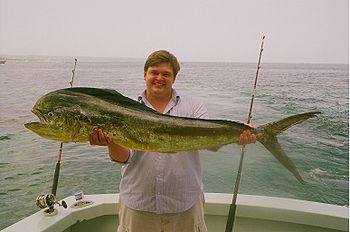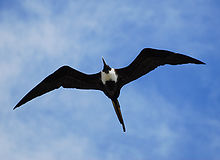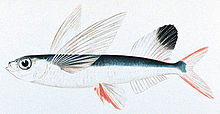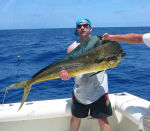Mahi-mahi fishing
From Wikipedia, the free encyclopedia


Female mahi-mahi caught off the coast of Jamaica
Mahi-mahi are swift and acrobatic game fish with striking colours. Their sides are golden with iridescent greens and blues, and their belly is white and yellow. These colours can change rapidly, excited fish "light up", and dying mahi-mahi often turn silvery over-all with blue spots on the flanks. These colours darken when the fish dies (see illustrations)[1] The currentIGFA all tackle record is 39.91 kilograms (88lb), caught in 1998 in Exuma,Bahamas.[2] Catches average 7 to 13 kilograms (15 to 29 lb), and any mahi-mahi over 18 kilograms (40 lb) is exceptional. Males are larger than females.
Mahi mahi are also known as dorado or dolphin fish. However, they are not at all related to dolphins. Dolphins are air-breathing mammals, whereas mahi mahi are water-breathing fish, distantly related to perch. They are good food fish, similar to flounder, tilapia and other whitefish.
Description


Bull (male) mahi-mahi caught in the Florida Keys
Mahi-mahi are a blue-water, open ocean, highly migratory schooling fish found around the world in tropical and subtropical waters at depths up to 85 metres (279 ft), but more typically near 37 metres (121 ft). They feed on forage fish, such as mackerel and squid, and also zooplanktonand crustaceans.[1][3] They are particularly adapted to hunting flying fish.[4]
They spawn in warm ocean currents throughout much of the year, and their young are often found among seaweed. They are a relatively short lived species, with a life span of only four or five years. Mahi-mahi are among the fastest growing fish, with a minimum population doubling time under 15 months. This makes them resilient to fishing pressure.[1] However, their currentvulnerability is moderate to high.[5]
Fishing techniques


Frigate birds can indicate the presence of mahi-mahi.
In earlier years, most mahi-mahi were caught accidentally, as bycatch in tuna and swordfishlongline commercial fisheries. Now they are sought by both commercial and recreational fishermen.
A typical fishing technique is to take a sport fishing boat to the edge of a reef in about 120 feet (37 m) of water and troll near a line of floating sargasso weed . Mahi-mahi often congregate around marine debris such as floating boards, palm trees and fronds, often found in association with such weed lines.[6] Sargasso sometimes holds a complete ecosystem from microscopic creatures to seahorses, small crabs, juvenile triggerfish and other bait fish. Frigate birds dive for the food accompanying the debris or sargasso. Other fish may be present in the area. Experienced fishermen can tell what species are likely around the debris by the birds' behaviour.


Mahi-mahi hunt flying fish
Mahi-mahi typically are taken by trolling ballyhoo on the surface with 30 to 50 pound line test tackle. Once a school of Mahi are encountered, casting with small jigs or Fly casting using a bait-and-switch technique can be successful. Ballyhoo or a net full of live sardines tossed into the water can be used to excite the mahi-mahis into a feeding frenzy. Hookless teaser lures can also be employed in the same manner. The teasers or live chum are tossed into the water, the fly is thrown to the feeding mahi-mahi. Once hooked, mahi-mahi are acrobatic game fish displaying spectacular blue, yellow and green colours.
A very different technique uses land based kites, instead of boats and rods, as the mechanism for delivering the terminal tackle at the end of a fishing line. This method has been used to catch mahi-mahi from cliff tops in Hawaii.[7]
In French Polynesia, mahi-mahi are caught with a harpoon. Mahi-mahi don't dive when they are pursued. A specifically designed boat, called the poti marara, is used. This boat is a powerful motorized V-bottom boat, optimized for high agility and speed, and driven with a stick so that the pilot can hold his harpoon with his right hand.[8]

Female mahi-mahi caught in Mauritius
Mahi-mahi are found around the world in all tropical and subtropical oceans.[9] Around North America, mahi-mahi are fished recreationally along the Pacific coast, particularly in the Gulf of California, off the coast of Costa Rica, and offshore in the Atlantic Ocean from New Jersey toFlorida. Popular recreational fisheries for mahi-mahi are located in the Gulf of Mexico, along the Pacific coast of Costa Rica and the Caribbean Sea, around Hawaiʻi, around Southeast Asia, and along the coast of Oman in the Arabian Sea.[10]
จากวิกิพีเดีย สารานุกรมเสรี
ปลาอีโต้มอญ (Common dolphin fish) เป็นปลาผิวน้ำที่พบตามนอกชายฝั่งทะเลเขตร้อนและกึ่งเขตร้อนทั่วโลก เป็น 1 ใน 2 ชนิดของปลาที่เป็นสมาชิกในตระกูล Coryphaenidae โดยอีกชนิดหนึ่งคือ Pompano dolphin fish ปลาอีโต้มอญมีชื่อเรียกในภาษาฮาวายว่า "Mahi-mahi" ชื่อนี้เพิ่งถูกนำมาใช้เรียกเมื่อไม่กี่ปีมานี้ โดยเฉพาะบนรายการอาหาร เพื่อไม่ให้เรียกสับสนกับโลมาซึ่งเป็นสัตว์เลี้ยงลูกด้วยนม
]การจับ


ปลาอีโต้มอญที่จับได้ใน Florida Keys
การจับปลาอีโต้มอญมักเป็นไปในลักษณะกีฬาตกปลาและการประมงเชิงพาณิชย์ กีฬาตกปลาชนิดนี้เป็นที่นิยมมากเพราะเป็นปลาที่มีความสวยงามและมีแรงต่อสู้มาก เช่นเดียวกับการประมงซึ่งมีการจับปลาชนิดนี้เพื่อเป็นอาหาร เนื่องจากเป็นที่รู้กันว่าปลาชนิดนี้มีเนื้อแน่นและรสชาติดี
แหล่งที่พบ
ปลาอีโต้มอญพบได้ทั้งในทะเลแคริบเบียน ชายฝั่งตะวันตกของอเมริกาเหนือและใต้ ชายฝั่งเอเชียตะวันออกเฉียงใต้ และทะเลอีกหลายๆแห่งทั่วโลก สหรัฐอเมริกาและประเทศในแถบแคริบเบียนเป็นกลุ่มผู้บริโภคผลิตภัณฑ์จากปลาอีโต้มอญกลุ่มใหญ่ของโลก ส่วนหลายๆประเทศที่พัฒนาแล้วในยุโรปมีปริมาณการบริโภคเพิ่มมากขึ้นทุกปี และญี่ปุ่นก็เป็นประเทศที่บริโภคปลาชนิดนี้เป็นปริมาณมากเช่นกัน
โต้มอญ
วงศ์ คอรีฟีนิสด์ (FAMILY CORYPHAENIDAE)
ชื่อไทย : อีโต้มอญ
ชื่ออังกฤษ : Dolphin fish (Mahimahi)
ชื่อวิทยาศาสตร์ : Coryphaena huppurus (Linnacus)
แหล่งอาศัย : อาศัยอยู่ในทะเลเปิดโดยทั่วไป ตามบริเวณผิวพื้นทะเล ไล่จับกินปลาเล็กหรือสิ่งที่เคลื่อนไหวเมื่อตัวใหญ่จึงออกไปอยู่ในทะเลลึก บางทีเราจะพบมันออกันอยู่กับขอนไม้ที่ลอยน้ำมา หรือเข้ามาไล่กินลูกปลาเล็ก ๆ ตามซั้งเป็นฝูง
ลักษณะ : ลำตัวแบน มีลักษณะคล้าย ๆ มีดอีโต้ ส่วนหัวโตค่อย ๆ เรียวลงมาทางด้านหางปากกว้างใหญ่เฉียบลง ฟันละเอียด ครีบหลังเป็นครีบอ่อนทั้งหมดยาวตั้งแต่บริเวณโหนกหัวถึงโคนหางมีสีดำเรื่อ ๆ อมเหลือง ลำตัวด้านบนสีเขียวเข้มและสีฟ้า ข้างตัวมีสีเหลืองอมน้ำเงิน และเป็นสีเงินมีจุดดำเล็ก ๆ ประปรายอยู่ทั่วหลัง ครีบหูมีมาก ครีบหางใหญ่แฉกกว้างเว้าเข้าบ่งให้เห็นความว่องไวและพละกำลังในการว่ายน้ำเกล็ดเล็กละเอียด หนังหนาแบบเดียวกับช่อนทะเล ตัวผู้สังเกตเห็นได้ง่ายจากโหนกหน้าซึ่งเกือบตั้งฉาก ผิดกับตัวเมียที่เป็นรูปโค้งลวดลงมา ขนาดยาวสูงสุดมากกว่า 2 เมตร หนักมากกว่า 50 กิโลกรัม โดยปกติตัวเมียมักโตกว่าตัวผู้
อุปนิสัย : เป็นปลาซึ่งสายตาดีมาก ความว่องไวในการว่ายน้ำของมันทำให้มันสามารถพุ่งเข้าหาเหยื่อที่เคลื่อนไหวไกลออกไปเป็นสามสิบสี่สิบเมตร มันเกิดมาเพื่อท้าทายกับกฎเกณฑ์กติกาการต่อสู้ทั้งหลายทั้งปวงของกีฬาตกปลา เทียบน้ำหนักตัวปอนด์ต่อปอนด์มันทรหดกว่า เหินหาวขึ้นเหนือน้ำมากกว่า
คุณค่าทางอาหาร : เป็นปลาที่ใช้ทำปลาดิบที่อร่อยที่สุดในโลก ว่ากันอย่างนั้น ใช้ประกอบอาหารต้มยำทำแกงได้ดีทุกประเภท หรือจะทำเค็มก็อยู่ในลำดับเดียวกับปลาสละ อร่อย แม้เนื้อจะแข็งกว่าปลาสละเล็กน้อย ปกติไม่ค่อยมีขายกันในท้องตลาด เพราะว่ากันว่าเป็นปลาที่มีจำนวนน้อยมากในประเทศเรา ที่ฮาวายใช้มันเป็นเหยื่อล่อมาร์ลิน เขาเรียกมันว่า มาฮี มาฮี ซึ่งใช้เป็นอาหารรับแขกเมืองด้วย และจะต้องเป็นโต้มอญเท่านั้น จนชื่อนี้ได้กลายเป็นชื่อพื้นเมืองหรือสมญาของมันไปแล้ว




